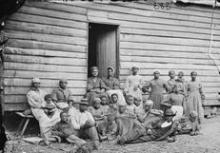Unlike Columbus, the colonists were unable to make the Indians work for them as slaves. According to Zinn, there were two primary reasons. First, the North American Indians (mostly Pequots at this time) were much better guerilla fighters and tactically, were far superior to their invaders. Although the colonists had superior technology, they were unable to find the Indians most of the time, let alone subjugate them. And this brings us to the second point; most of the settlers were craftsmen and men of leisure, not soldiers. These colonists had come to the New World seeking political or religious freedom, and didn't have the training, or even the inclination, or work fo themselves let alone exploit the natives. In one account, John Smith is actually forced to put his people in work gangs in order to get them to plant and harvest their fields.
Zinn takes time to explore the notion of inferiority of blacks to whites at this time. Of course, it was the ideation (and justification) of the white Europeans that blacks as a people, as a culture, and as a living being, were inferior to the white races and so deserving of enslavement. Zinn points out that cultures that can make the subjugation of another culture practical and profitable, will always make it morally justifiable as well. The colonists of North America needed slaves, and though they were able to burn, kill, and torture the native Indians they had not been able to enslave them. However, African slaves, torn from their native lands (which provided Native Americans some protection) and their own culture (which provided European whites some control) were easily exploited and controlled.(25)
Over the next 100 years, and as colonies in the New World grew to cities demanding greater and greater investments in agriculture and other economies, slavery grew from a small enterprise to a booming industry. Zinn describes the conditions of the capture and travel from Africa to the western colonies in vivid and tragic detail. Often African tribes were completely desimated by slavers, and were sometimes marched a thousand miles to the coast, of which the strain would kill 2 in 5. The conditions on the ship were even worse. Slaves were packed like fish into the holds of massive slaving ships, where they were chaiend to a space not larger than a coffin and were left to endure the several month-long journey across teh Atlantic. It's estimated that perhaps 1 in every 3 human beings transported this way died, but that the profits upon reaching market for each slave sold was double the amount. Howard Zinn remarks, "By 1800, 10 to 15 million blacks had been transported as slaves to the Americas, representing perhaps one-third of those originally seized in Africa. It is roughly estimated that Africa lost 50 million human beings...in those centuries we call the beginnings of modern Western civilization." (29)
Zinn goes to great lengths to point ou the hitorical roots of racism in the United States, fueled by a hunger for profit and productivity. At the height of the slave trade 3 million black slaves had been stripped of their cultural identity and socialized to understand their "place". It was bouyed by the temptation of poor whites, particularly in the South, to exercise power over another, and by a socio-psychological need for the subjugation of blacks in the Southern identity. However, as the U.S. prospered and grew, and a new elite land-owning aristocracy was developing, poor whites began to develop a class consciousness, and began to understand their role within the emerging hierarchy of power and powerlessness. This would ultimately lead to a revolution.
Photo from blog.encyclopediavirginia.org
